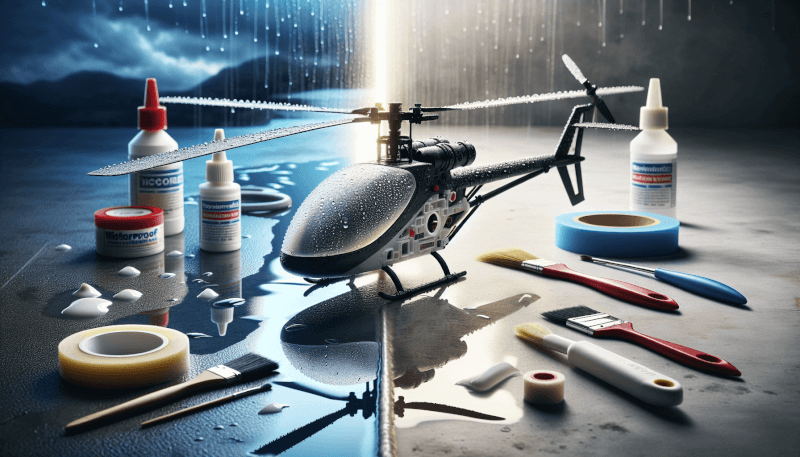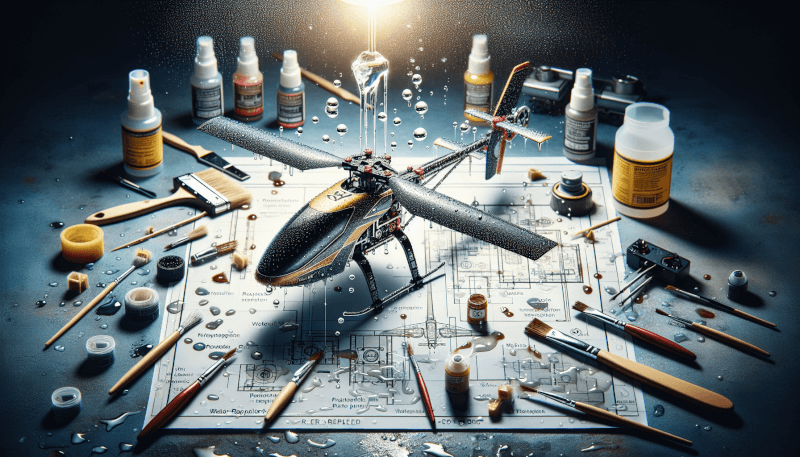Are you tired of worrying about the weather ruining your RC helicopter flying adventures? Look no further than “The Ultimate Guide to Waterproofing Your RC Heli.” This comprehensive guide will provide you with all the essential tips and tricks to protect your beloved RC helicopter from water damage, allowing you to enjoy your hobby, rain or shine. From sealing electronics to choosing the right waterproofing materials, this guide has got you covered. So, get ready to take your RC heli to new heights, without any fear of water interference!

What is RC Heli?
Definition of RC Heli
RC Heli, short for radio-controlled helicopter, is a miniature flying machine that can be remotely controlled by an operator using a handheld transmitter. These helicopters are scaled-down replicas of their full-sized counterparts and are often used for recreational purposes, aerial photography, or even in professional competitions. RC Helis are equipped with various electronic components, including motors, receivers, and batteries, which allow them to take flight and perform intricate maneuvers.
Different types of RC Helis
There are several different types of RC Helis available, each designed to cater to different skill levels and preferences of enthusiasts. The most common types include:
- Fixed-Pitch Helicopters: These are the simplest and most beginner-friendly RC Helis. They have a fixed rotor blade pitch, making them easier to control and fly.
- Collective-Pitch Helicopters: These advanced helicopters have adjustable rotor blade pitch, allowing for greater maneuverability and more complex flight patterns.
- Micro Helicopters: These small-sized helicopters are perfect for indoor use and beginners who want to practice their flying skills in confined spaces.
- Outdoor Helicopters: Designed for outdoor use, these RC Helis typically have larger frames and more powerful motors to withstand wind and other weather conditions.
Why Waterproofing is Important
Protection against water damage
When it comes to RC Helis, water damage is a common concern that can easily ruin expensive electronic components. Whether you’re flying your RC Heli near a pond, in rainy weather, or in wet conditions, water can seep into vulnerable parts of the helicopter and cause irreparable damage. Waterproofing your RC Heli not only protects it from water-related accidents but also ensures the longevity and performance of its electronic components.
Enhanced durability and longevity
Waterproofing your RC Heli increases its overall durability and lifespan. By sealing vulnerable areas, such as electronic circuits and connectors, you prevent moisture from corroding or short-circuiting these crucial components. Additionally, waterproofing can protect against other environmental elements such as dust, dirt, and debris, extending the life of your RC Heli and reducing the need for frequent repairs or replacements.
Preparation for Waterproofing
Gathering necessary supplies
Before you begin the waterproofing process, it’s essential to gather the necessary supplies. You will need the following items:
- Waterproof sealants or coatings: There are various sealants and coatings available specifically designed for RC Helis. Look for products that are suitable for the type of materials your helicopter is made of.
- Isopropyl alcohol or contact cleaner: Use these cleaning agents to remove any dirt, grease, or residue from the surfaces you plan to waterproof.
- Small brushes and cotton swabs: These tools are handy for applying sealants or coatings and cleaning hard-to-reach areas.
- Heat gun or hairdryer: A heat gun or hairdryer can be used to speed up the drying process after applying sealants or coatings.
- Plastic bags or covers: These will be used to protect certain parts of the RC Heli during the waterproofing process.
Cleaning the RC Heli
Before applying any waterproofing methods, it’s important to thoroughly clean your RC Heli. Use isopropyl alcohol or contact cleaner to remove any dirt, grime, or residue from the helicopter’s surfaces. Pay close attention to areas that are prone to moisture accumulation, such as the electronic components, connectors, and seams. Use small brushes or cotton swabs to clean hard-to-reach areas. Allow the helicopter to dry completely before proceeding with the waterproofing process.
Choosing the Right Waterproofing Method
Options for waterproofing
There are several methods available for waterproofing your RC Heli, each offering varying degrees of protection. Some common options include:
- Sealing with silicone: Silicone sealants are widely used for waterproofing RC Helis. They create a protective barrier against water, dust, and debris. Apply silicone sealant to areas such as electronic connections, motor mounts, and any seams or openings that could allow water to penetrate.
- Conformal coating: Conformal coatings are specially formulated to protect electronic components by creating an insulating layer. These coatings can be sprayed or brushed onto the circuit boards, connectors, and other sensitive areas. They provide excellent protection against moisture, chemicals, and temperature fluctuations.
Considerations for different RC Helis
The waterproofing method you choose may vary depending on the type of RC Heli you own. For example, micro helicopters may require a lighter coating or sealant due to their smaller size and weight constraints. Similarly, outdoor helicopters that are exposed to more extreme weather conditions may require a more robust waterproofing solution. Consider the specific characteristics and needs of your RC Heli when selecting the appropriate waterproofing method.

Waterproofing Electronics
Sealing electronic components
One of the most critical aspects of waterproofing your RC Heli is protecting the electronic components. Apply silicone sealant or conformal coating to all exposed electronic connections, circuit boards, and other vulnerable areas. Be sure to cover connectors, servo leads, and any exposed wires to prevent water infiltration. Take care to avoid covering essential ventilation areas to prevent overheating.
Using conformal coating
Conformal coating is an excellent option for protecting electronic components from water damage. Apply the conformal coating evenly over the circuit boards, connectors, and any other sensitive areas using a brush or spray. Allow the coating to dry thoroughly before reinstalling any components. This insulating layer will provide an additional level of protection against moisture and other environmental elements.
Protecting the Body and Frame
Applying waterproof sealants
In addition to protecting the electronic components, it’s important to waterproof the body and frame of your RC Heli. Apply waterproof sealants or coatings to the seams, joints, and connections within the frame to prevent water seepage. Consider using a silicone-based sealant that is specifically formulated for the materials your helicopter is made of. Apply the sealant evenly and allow it to cure fully before exposing the RC Heli to any wet conditions.
Using protective covers
Another way to protect the body and frame of your RC Heli is by using protective covers. These covers are designed to fit snugly over your helicopter’s body, providing an extra layer of protection against moisture, dirt, and debris. Ensure that the cover you choose is waterproof and fits properly to prevent water from seeping in. Additionally, some covers come with built-in ventilation ports to allow for heat dissipation and prevent overheating.

Waterproofing the Battery
Applying battery waterproofing solutions
The battery is a crucial component of your RC Heli that requires special attention when waterproofing. To protect it from moisture, apply a battery waterproofing solution or sealant to the battery connections and terminals. Ensure that the solution you choose is compatible with the battery type you’re using. Apply the sealant evenly, covering any exposed areas, and allow it to dry completely before reconnecting the battery to the helicopter.
Using waterproof battery covers
Another option for waterproofing your RC Heli’s battery is to use waterproof battery covers. These covers are designed to wrap around the battery, providing a protective barrier against water and other elements. Choose a cover that is specifically designed for your battery’s dimensions and ensure that it fits securely. Waterproof battery covers are an easy and effective way to safeguard your battery during wet flying conditions.
Maintaining Waterproofing
Regular inspections and maintenance
To ensure the effectiveness of your waterproofing efforts, it’s important to conduct regular inspections and maintenance. Check for any signs of water damage, corrosion, or wear and tear on a routine basis. Inspect the seals, sealants, and covers for any cracks, gaps, or deterioration. Address any issues promptly to maintain optimal waterproofing and prevent potential damage to your RC Heli’s electronic components.
Reapplication of waterproofing methods
Over time, the effectiveness of waterproofing sealants and coatings may diminish, especially with frequent use or exposure to harsh conditions. It is important to periodically reapply the waterproofing methods to ensure continuous protection. Follow the manufacturer’s guidelines for reapplication, and be sure to clean and dry the helicopter thoroughly before applying any new sealants or coatings.

Tips and Tricks for Flying in Wet Conditions
Pre-flight checks
When flying in wet conditions, it’s essential to perform thorough pre-flight checks to ensure the safety and proper functioning of your RC Heli. Check the waterproof seals, connectors, and covers for any signs of damage or wear. Verify that all electronic connections are secure and free from moisture. Inspect the battery for any signs of water infiltration. Conducting these checks before each wet flying session will help prevent water-related accidents and ensure a smooth flight experience.
Flying techniques
Flying an RC Heli in wet conditions requires a different set of skills and techniques. As moisture can affect the helicopter’s stability and responsiveness, it’s important to fly with caution. In wet or rainy weather, maintain a lower altitude to minimize the impact of wind and to avoid water-related mishaps. Adjust your flying style accordingly to account for reduced maneuverability and be prepared for slower response times. Fly in open areas to avoid obstacles and always keep a safe distance from potential water hazards.
Conclusion
Importance of waterproofing for RC Helis
Waterproofing your RC Heli is crucial for protecting its electronic components, enhancing durability, and prolonging its lifespan. Without proper waterproofing, water damage can easily occur, leading to costly repairs or even rendering your helicopter unusable. By following the appropriate waterproofing methods and regularly maintaining your RC Heli, you can enjoy flying even in wet conditions while ensuring the longevity and performance of your beloved flying machine.
Summary of waterproofing methods and tips
In summary, the process of waterproofing your RC Heli involves gathering the necessary supplies, cleaning the helicopter, choosing the right waterproofing method based on your needs, and then implementing the chosen method. This includes sealing electronic components, protecting the body and frame with waterproof sealants or covers, waterproofing the battery with solutions or covers, and maintaining waterproofing through regular inspections and reapplication of methods. Additionally, flying in wet conditions requires pre-flight checks and adjusted flying techniques. By following these steps, you can confidently take your RC Heli to new heights without worrying about water damage.



